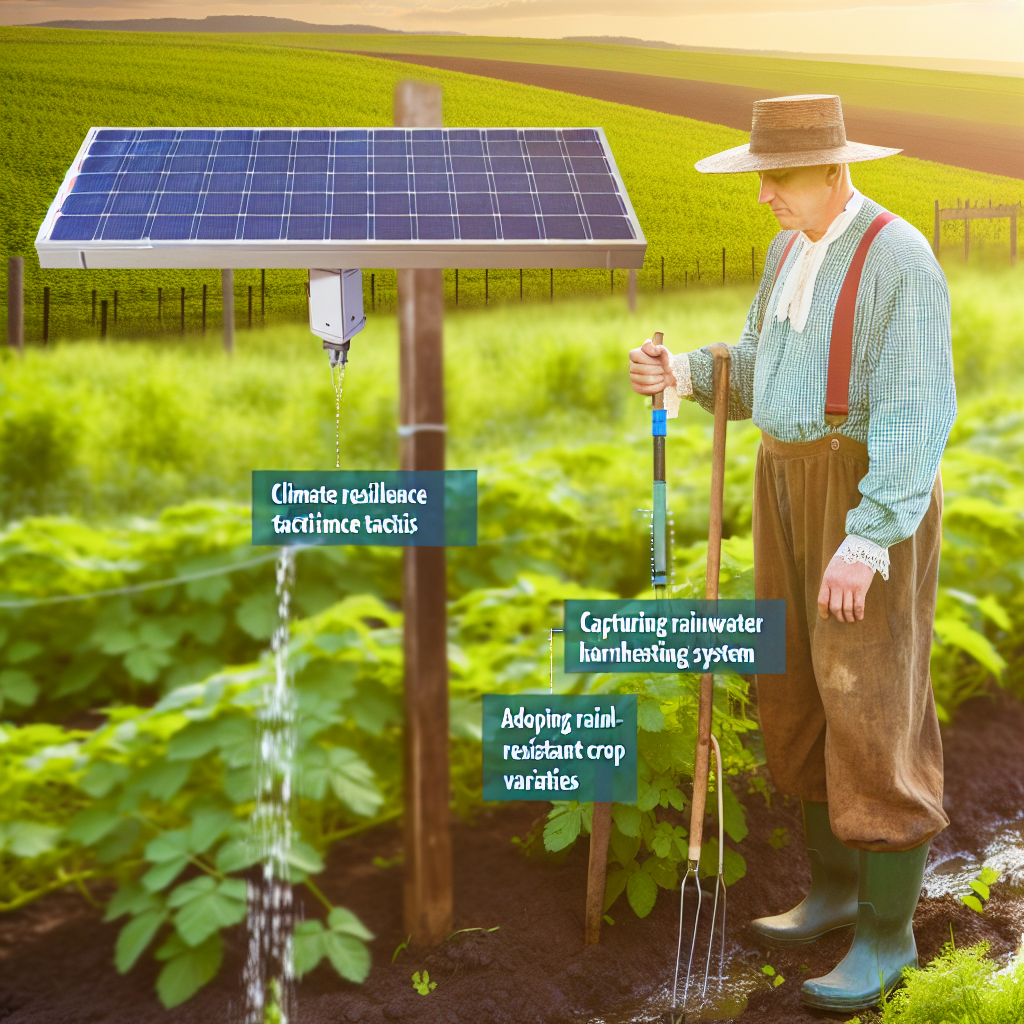Introduction to Climate Resilience
Climate resilience is crucial for farmers today.
The impacts of climate change are severe and widespread.
Farmers face increasing weather variability and extreme events.
Consequently, they must adopt strategies to adapt and thrive.
Understanding Climate Change Impacts
Weather patterns are becoming more unpredictable.
Increased droughts and floods threaten crop yields.
These challenges also affect soil health and water resources.
Farmers must recognize these risks to adjust their practices.
The Importance of Adaptation
Adaptation helps farmers maintain productivity under changing conditions.
It allows them to protect their livelihoods and investment.
Moreover, adaptive strategies can enhance resource efficiency.
In turn, this contributes to long-term sustainability in agriculture.
Building Resilience through Innovation
Innovation plays a critical role in building climate resilience.
Farmers can leverage new technologies for better decision-making.
For instance, precision agriculture enhances resource use.
Transform Your Agribusiness
Unlock your farm's potential with expert advice tailored to your needs. Get actionable steps that drive real results.
Get StartedAdditionally, crop diversification mitigates risks associated with climate change.
In essence, embracing innovation is essential for future success.
Understanding the Impact of Climate Change on Agriculture
Overview of Climate Change Effects
Climate change significantly affects global agriculture.
Rising temperatures lead to altered growing seasons.
Additionally, increased precipitation variability disrupts crop yields.
Farmers face heightened risks from droughts and floods.
Climate change also affects pest and disease patterns.
Impact on Crop Production
Many staple crops are particularly vulnerable to climate change.
For instance, wheat and rice production may decline in some regions.
This jeopardizes food security for millions globally.
Furthermore, pests thrive in warmer climates, damaging crops.
Consequences for Livestock
Livestock farming experiences its own set of challenges.
Heat stress negatively impacts animal health and productivity.
Moreover, feed and water availability fluctuate with climate variations.
This increases costs for farmers and reduces their income.
Economic Implications
Climate change can have far-reaching economic effects on agriculture.
Reduced yields lead to higher prices for consumers.
Additionally, farmers may face increased insurance costs.
Investment in climate-resilient practices becomes critical for sustainability.
Adaptation Strategies
Farmers must adopt new strategies to address these challenges.
Implementing sustainable practices can mitigate risks effectively.
For example, crop rotation improves soil health and resilience.
Furthermore, investing in technology can enhance adaptive capacity.
Soil Health Management: Techniques for Enhancing Resilience
Understanding Soil Health
Soil health is fundamental to successful farming practices.
Showcase Your Farming Business
Publish your professional farming services profile on our blog for a one-time fee of $200 and reach a dedicated audience of farmers and agribusiness owners.
Publish Your ProfileIt encompasses the biological, chemical, and physical properties of soil.
Healthy soil supports plant growth and retains water effectively.
Moreover, it enhances crop resilience to extreme weather events.
Importance of Organic Matter
Incorporating organic matter significantly boosts soil health.
Organic matter improves soil structure and moisture retention.
Additionally, it enhances the soil’s nutrient-holding capacity.
Farmers can use compost and cover crops to increase organic matter.
Implementing Crop Rotation
Crop rotation helps manage soil nutrient levels.
This practice reduces pest and disease buildup in the soil.
Furthermore, rotating crops enhances biodiversity on the farm.
Consider alternating between legumes and cereals for best results.
Cover Cropping Techniques
Utilizing cover crops is effective for soil protection.
These crops prevent erosion and improve soil fertility.
During off-seasons, cover crops can enhance organic matter levels.
Common choices include clover, vetch, and rye.
Utilizing Mulching
Mulching provides multiple benefits for soil health.
It helps control weeds and maintains soil moisture levels.
Additionally, mulch contributes organic matter as it decomposes.
Use straw, wood chips, or grass clippings as effective mulch materials.
Monitoring Soil pH
Regularly testing soil pH is crucial for optimal plant growth.
Different crops require different pH levels to thrive.
If necessary, amend soil pH with lime or sulfur.
This practice ensures crops can effectively absorb nutrients.
Participating in Soil Health Programs
Many organizations offer programs promoting soil health practices.
Engaging with these programs provides valuable resources.
Additionally, farmers gain insights into sustainable techniques.
Consider joining local cooperatives or extension services.
Delve into the Subject: Improve Farm Productivity with Carbon Sequestration
Water Conservation Strategies: Efficient Use and Harvesting
Importance of Water Conservation
Water is a vital resource for farming.
Farmers must conserve water to maintain productivity.
Effective strategies improve crop resilience.
Rainwater Harvesting Techniques
Collecting rainwater is an excellent conservation method.
Farmers can install barrels to gather rainwater from roofs.
Utilizing this water reduces dependency on municipal sources.
Soil Moisture Management
Healthy soil retains moisture effectively.
Farmers can apply mulching to reduce evaporation.
This practice helps maintain consistent soil moisture levels.
Efficient Irrigation Practices
Implementing drip irrigation optimizes water usage.
This technique delivers water directly to plant roots.
It reduces waste and promotes healthy growth.
Showcase Your Farming Business
Publish your professional farming services profile on our blog for a one-time fee of $200 and reach a dedicated audience of farmers and agribusiness owners.
Publish Your ProfileCover Cropping Benefits
Using cover crops enhances soil structure and moisture retention.
These crops protect soil from erosion during dry periods.
They also improve nutrients for future plants.
Scheduling Irrigation Smartly
Farmers should plan irrigation according to weather patterns.
Irrigating early in the morning minimizes evaporation loss.
Using moisture sensors can enhance irrigation efficiency.
Water Recycling Approaches
Recycling water from farming processes is a sustainable choice.
Farmers can treat greywater for irrigation purposes.
This method conserves freshwater resources effectively.
Learn More: Solar and Wind Technologies for Sustainable Farming
Crop Diversification
Benefits of Crop Diversification
Crop diversification enhances resilience against climate change.
This strategy reduces dependency on a single crop type.
By diversifying, farmers can stabilize their income streams.
Additionally, it improves soil health through varied root structures.
Crop diversity attracts beneficial insects, aiding natural pest control.
Moreover, it enhances food security in local communities.
Implementation Methods
Implementing crop diversification requires careful planning.
First, assess the local climate and soil types.
Choose complementary crops that thrive together.
Rotate crops annually to prevent soil depletion.
Engage with local agricultural extension services for guidance.
Choosing the Right Crops
Consider market demand when selecting crops.
Incorporate native plants that require less water.
Experiment with cover crops to improve soil quality.
Include legumes to fix nitrogen in the soil.
Monitoring and Adjustment
Regular monitoring is essential after implementation.
Track crop performance and make adjustments as needed.
Evaluate pest and disease patterns to inform future choices.
Stay informed on market trends to maximize profits.
Community and Collaboration
Join local cooperatives to share knowledge and resources.
Participate in workshops focused on sustainable practices.
Collaborate with research institutions for innovative solutions.
Networking with other farmers can provide valuable support.
Find Out More: Using Technology to Optimize Water Use on Farms
Agroforestry Practices: Integrating Trees for Sustainability
Benefits of Agroforestry
Agroforestry combines agriculture and forestry practices.
This integration offers multiple environmental benefits.
For instance, it enhances biodiversity on farms.
Additionally, it captures carbon, thus mitigating climate change.
Furthermore, agroforestry improves soil health and fertility.
It also reduces erosion by stabilizing the soil with tree roots.
Showcase Your Farming Business
Publish your professional farming services profile on our blog for a one-time fee of $200 and reach a dedicated audience of farmers and agribusiness owners.
Publish Your ProfileDiverse Planting Techniques
Farmers can adopt various planting methods in agroforestry.
One common technique is alley cropping.
This method involves planting crops between rows of trees.
Another approach is silvopasture, which integrates trees with livestock.
This combination utilizes shade to benefit animal health.
Moreover, windbreaks can protect crops and livestock from harsh winds.
Choosing the Right Trees
Selecting appropriate tree species is crucial.
Farmers should consider local climate and soil conditions.
Native species often adapt better to the environment.
Additionally, fruit-bearing trees provide extra sources of income.
Consulting with local agricultural extensions can aid in selection.
Supporting Local Ecosystems
Agroforestry practices promote healthy ecosystems.
This method supports wildlife habitats while maintaining farm productivity.
Furthermore, it encourages pollinator populations, critical for crop yield.
Integrating trees fosters a symbiotic relationship with nature.
Implementation Strategies
Implementing agroforestry requires careful planning.
Farmers should assess their land for suitable conditions.
Conducting soil tests can determine nutrient needs.
Creating a management plan ensures long-term success.
Engaging with local communities can provide support and resources.
Find Out More: Carbon Footprint Reduction Methods for Farmers

Climate-Smart Technology: Innovations for Resilient Farming
Introduction to Climate-Smart Technology
Climate-smart technology equips farmers to adapt to changing conditions.
It enhances productivity while reducing greenhouse gas emissions.
This approach focuses on sustainable agricultural practices.
Precision Agriculture
Precision agriculture uses data to optimize farming processes.
This method boosts crop yields and minimizes resource waste.
Farmers can monitor soil conditions and crop health in real-time.
By utilizing GPS technology, they enhance field mapping.
As a result, farmers apply fertilizers and pesticides more effectively.
Benefits of Precision Agriculture
- Increased efficiency in resource use
- Reduction in environmental impact
- Improved yield and profit margins
Improved Irrigation Techniques
Innovative irrigation techniques ensure optimal water usage.
Drip irrigation systems deliver water directly to the roots.
This method minimizes evaporation and runoff.
Farmers can utilize rainwater harvesting systems effectively.
These systems increase water resilience during drought conditions.
Benefits of Improved Irrigation Techniques
- Conservation of water resources
- Enhanced crop resilience to drought
- Lower energy costs for water transportation
Crop Diversification
Crop diversification enhances resilience against climate variability.
Diverse crops reduce risks related to pests and diseases.
Farmers can adapt to market demands and changing weather patterns.
Additionally, this practice improves soil health and biodiversity.
Benefits of Crop Diversification
- Increased ecosystem stability
- Higher nutritional diversity for consumers
- Improved economic returns for farmers
Use of Climate-Resistant Crop Varieties
Climate-resistant crops withstand extreme weather conditions.
They require less water and resist diseases effectively.
Showcase Your Farming Business
Publish your professional farming services profile on our blog for a one-time fee of $200 and reach a dedicated audience of farmers and agribusiness owners.
Publish Your ProfileFarmers can seek varieties developed through research initiatives.
This ensures better survival rates under stress conditions.
Benefits of Climate-Resistant Crop Varieties
- Increased resilience to climate challenges
- Improved food security in vulnerable regions
- Reduction in dependency on chemical inputs
Integrating Agroecological Approaches
Agroecology incorporates ecological principles into farming systems.
This method enhances soil fertility and biodiversity.
Farmers can create synergies between crops and livestock.
Moreover, agroecological practices help build community resilience.
Benefits of Agroecological Approaches
- Improved soil health and fertility
- Increased resilience to climate change impacts
- Support for local food systems and economies
Building Community Networks
Importance of Collaboration
Collaborating strengthens community ties among farmers.
It fosters resilience against climate change impacts.
Shared knowledge enhances agricultural practices.
Working together increases access to resources.
Creating Resource Pools
Farmers can establish collective resource pools.
This includes machinery, seeds, and funds.
Pooling resources reduces individual costs.
Additionally, it promotes efficient use of equipment.
Engaging in Cooperative Marketing
Cooperative marketing allows farmers to reach broader markets.
Farmers can collectively advertise their products.
This increases visibility and sales opportunities.
Marketing as a group can lead to better pricing.
Developing Local Support Networks
Local support networks provide essential assistance.
These networks connect farmers with experts and mentors.
They share best practices and new techniques.
Moreover, they offer emotional and practical support.
Encouraging Information Sharing
Regular meetings facilitate information sharing among farmers.
Workshops and seminars enhance skill building.
Farmers can discuss challenges and solutions together.
Online forums also provide a space for dialogue.
Building Partnerships with Organizations
Partnerships with local organizations can be beneficial.
These organizations may offer grants and technical support.
Furthermore, they can connect farmers with research institutions.
Working together fosters innovation and improvement.
Policy Advocacy and Support Programs
The Importance of Policy Advocacy
Effective policy advocacy empowers farmers to address climate challenges.
It allows them to influence decisions that affect their livelihoods.
By advocating for supportive policies, farmers can gain access to vital resources.
Furthermore, advocacy fosters collaboration among stakeholders in agriculture.
Understanding Support Programs
Support programs play a crucial role in enhancing climate resilience.
These programs provide financial assistance and technical guidance.
Farmers can benefit from various federally funded initiatives.
State and local programs also offer targeted support for specific needs.
Types of Support Programs
- Grants for sustainable farming practices.
- Subsidies for crop insurance and disaster relief.
- Educational programs on climate adaptation techniques.
- Technical assistance for implementing new technologies.
Navigating Agricultural Aid
Farmers often face challenges when seeking aid.
Understanding program eligibility is critical for success.
Showcase Your Farming Business
Publish your professional farming services profile on our blog for a one-time fee of $200 and reach a dedicated audience of farmers and agribusiness owners.
Publish Your ProfileFarmers should familiarize themselves with application processes.
Additionally, maintaining accurate records can streamline applications.
Collaborating with Advocacy Groups
Partnering with advocacy organizations can enhance farmers’ voices.
These groups help disseminate valuable information on available programs.
Moreover, they can provide training on effective advocacy strategies.
Farmers should engage in local and national advocacy efforts.
Staying Informed on Policy Changes
Farmers must stay updated on evolving policies.
Regularly checking government websites can provide timely information.
Additionally, attending workshops and forums can enhance awareness.
Networking with other farmers also fosters knowledge sharing.
Future Directions for Climate Resilient Farming
Innovative Agricultural Practices
Farmers continue to explore innovative agricultural practices.
These practices help adapt to changing climate conditions.
Integrating agroecology and permaculture shows promise.
Furthermore, vertical farming enables crop growth in urban settings.
These solutions can enhance food security in vulnerable areas.
Technological Advancements
Technological advancements play a crucial role in climate resilience.
Precision farming techniques optimize resource use effectively.
Farmers utilize drones for monitoring crops and assessing conditions.
Data analytics aid in forecasting weather patterns accurately.
Collaboration and Knowledge Sharing
Collaboration among farmers strengthens community resilience.
Sharing knowledge about successful strategies fosters innovation.
Local agricultural cooperatives can facilitate these exchanges.
Moreover, partnerships with research institutions drive progress.
Policy and Support Systems
Strong policy frameworks support climate-resilient farming.
Governments should promote sustainable practices through incentives.
Financial assistance helps farmers adopt new technologies.
Additionally, access to information about climate risks is essential.
Community Engagement and Education
Engaging communities boosts awareness of climate issues.
Education programs highlight adaptive farming practices.
Workshops and training sessions can empower local farmers.
Moreover, strong community networks enhance problem-solving capabilities.
Additional Resources
Reaching Smallholder Women with Information Services and …
Climate-Smart Agriculture and Forestry Resources | Farmers.gov




